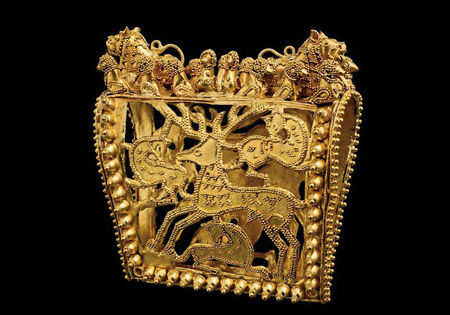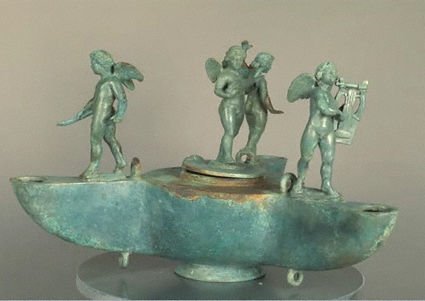'The Golden Graves of Ancient Vani' @ the J. Paul Getty Museum
Headdress Ornament with Animals and Birds, Colchian, 350–300 B.C. Gold. Greatest extent: H: 6.6 x W: 6.5 x D: 2.7 cm (2 5/8 x 2 9/16 x 1 1/16 in.) Georgian National Museum, Tbilisi, Georgia, 1-2005/1. Photo: Amiran Kiladze.VEX.2009.4.106
LOS ANGELES, CA.- In a spectacular display of archaeological finds, The Golden Graves of Ancient Vani, on view from July 16–October 5, 2009, at the J. Paul Getty Museum at the Getty Villa, presents more than 140 objects from one of the most celebrated archaeological sites in the Republic of Georgia, including four recently excavated bronze lamps, shown together for the first time.
Vani was an important settlement in the ancient kingdom of Colchis, a region best known as the destination of Jason and the Argonauts in their mythical quest for the Golden Fleece. Even in antiquity, Colchis was renowned as a region rich in gold, and excavations at Vani have confirmed this reputation. Prompted by reports of jewelry that came to the surface following heavy rainfall in the area, archaeologists in the late 1930s began to systematically explore Vani. Their excavations have uncovered a series of burials in which the deceased were laid to rest wearing a sumptuous array of ornaments, and have revealed that Vani was a major political and religious center.
The Golden Graves of Ancient Vani features an extraordinary array of objects, dating from the mid-fifth to mid-first centuries B.C. From an impressive variety of locally-made gold jewelry to imports from the Persian Empire and the Greek world, the ancient treasures in the exhibition reveal both the region’s rich material resources and a complex and fruitful network of interactions with neighboring peoples.
“This exhibition provides a wonderful opportunity to tell the story of this ancient temple city and give visitors a view into the complex interrelations of ancient cultures,” says Michael Brand, director of the J. Paul Getty Museum. “We are delighted to have these objects together here in Los Angeles for the very first time.”
David Lordkipanidze, director of the Georgian National Museum, adds, “We are delighted that these exquisite objects from one of Georgia’s most important archeological sites are serving as the cultural bridge between Georgian museums and American institutions such as the Getty Museum, the Smithsonian, and the Institute for the Study of the Ancient World at New York University. We are equally pleased to see the Getty Villa bejeweled by the magnificent Georgian treasures of Vani, providing audiences a glimpse into our country, its history, and rich culture. We hope this collaboration with the Getty Museum is only the beginning of a long lasting relationship between our institutions. ”
Although The Golden Graves of Ancient Vani, organized by the Institute for the Study of the Ancient World at New York University, has toured the United States and Europe, the Getty presentation includes four elaborate bronze lamps that were discovered during excavations at the site in 2007. Part of a hoard of precious bronzes, they may have been deposited during a time of crisis. The discovery of this well-preserved cache of ancient metalwork is significant for the light it sheds on the manufacture and use of bronze in ancient Colchis. Furthermore, the artistry of the lamps is difficult to parallel—for example, the careful rendering of the Indian elephant heads that serve as nozzles for an Incense Burner (250–100 B.C.), or the elaborate composition of the Lamp with Elephant Heads and Human Figures (250–100 B.C.). Two of the lamps—the Lamp with Zeus and Ganymede and Lamp with Erotes (250–100 B.C.)—have never been displayed before, and were brought to the Getty for cleaning and analysis as part of a collaborative project with Georgian archaeologists and conservators.
“This is the first time we’ve brought objects directly from an archaeological site to the Museum for treatment and conservation, which carries with it great responsibility. We have been extremely fortunate to have the opportunity to exchange knowledge and expertise with our Georgian colleagues and were delighted to have Dr. Nino Kalandadze, a visiting conservator morefrom the Georgian National Museum, at the Villa for several weeks working on the lamps with our conservation team,” says Jerry Podany, the Getty Museum’s senior conservator of antiquities.
The exhibition focuses on a treasure trove of objects from five of the 28 graves that have been excavated at the site so far. They date to 450–250 B.C, when Vani was at the height of its prosperity. Among them, Grave 11 is the earliest and perhaps the richest burial. Dating to the mid-fifth century B.C., it contains four bodies laid inside a wooden structure and, outside it, a horse. Although all four bodies wore jewelry, one—a woman—was much more elaborately adorned, indicating her elite status.
The Necklace with Turtle Pendants (about 450 B.C.), a stunning example of Colchian goldwork, is one of the five necklaces discovered in this grave. The shells of the turtles are intricately decorated with granulation—the application of numerous tiny gold spheres—and are indicative of the advanced skill of Colchian goldworkers.
Another burial, Grave 24, excavated in 2004, exemplifies the cultural contacts enjoyed by the local aristocracy, for alongside another assemblage of gold jewelry and adornments are vessels imported from—or inspired by—both the Greek world and the Persian Empire. Of particular interest is the Silver Belt (350–300 B.C.) that depicts a banqueter attended by servants, testifying to the cultural importance of feasting.
The other three burials featured in the exhibition include a grave of a woman (Grave 6), which contained a striking polychrome pendant, manufactured in the Persian Empire but imported and adapted for local use at Vani; the grave of a warrior (Grave 9), whose gold ring bears an inscription in Greek, Dedatos, which may be his name; and the grave of an infant girl (Grave 4), who was adorned with gold jewelry just like her elders.
“The archaeological finds not only demonstrate the highly refined craftsmanship of local goldworkers, but also testify to contacts with both the Greek world and the Persian Empire,” says Karol Wight, the Getty Museum’s senior curator of antiquities. “Through our presentation, we hope to introduce visitors to an ancient heritage that expands our knowledge of an important civilization in this region. Many of the objects unearthed at Vani are without parallel in the ancient Mediterranean world.”
After the mid-third century B.C., evidence of rich burials ceases at the site. Most of the structures—such as altars and cult buildings—seem to have a religious or ritual function and, according to some scholars, Vani served thereafter as a sanctuary-city. Among the treasures from this period is the Torso of a Youth (200–100 B.C.), a well-proportioned bronze in a style that recalls Greek sculptures dating to 490–460 B.C., but that seems to have been made locally. It was discovered in an archaeological context that indicates it was a victim of the military destruction sustained at Vani around 50 B.C., which brought activity at the site to an abrupt end.
Gold Phiale Mesomphalos, Vani, Achaemenid influence, 400-350 B.C. Georgian National Museum
In addition to the burials, other discoveries at Vani have shed light on Colchian culture. Most compelling are seven metal figurines, dating to 300–200 B.C., that have been discovered both in and near sacred structures at Vani. Two of them :

/https%3A%2F%2Fprofilepics.canalblog.com%2Fprofilepics%2F1%2F0%2F100183.jpg)










/http%3A%2F%2Fstorage.canalblog.com%2F83%2F79%2F577050%2F59788135_o.jpg)
/http%3A%2F%2Fstorage.canalblog.com%2F29%2F53%2F119589%2F55688791_p.jpg)
/http%3A%2F%2Fstorage.canalblog.com%2F55%2F59%2F119589%2F54994538_p.jpg)
/http%3A%2F%2Fstorage.canalblog.com%2F01%2F10%2F577050%2F53825934_o.jpg)